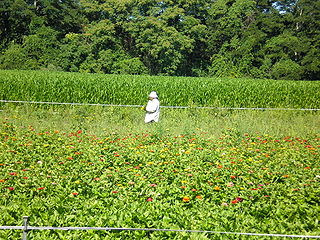Related Research Articles
The United Food and Commercial Workers International Union (UFCW) is a labor union representing approximately 1.3 million workers in the United States and Canada in industries including retail; meatpacking, food processing and manufacturing; hospitality; agriculture; cannabis; chemical trades; security; textile, and health care. UFCW is affiliated with the Canadian Labour Congress (CLC) and the AFL–CIO; it disaffiliated from the AFL–CIO in 2005 but reaffiliated in 2013. UFCW is also affiliated to UNI Global Union and the IUF.

Foreign workers or guest workers are people who work in a country other than one of which they are a citizen. Some foreign workers use a guest worker program in a country with more preferred job prospects than in their home country. Guest workers are often either sent or invited to work outside their home country or have acquired a job before leaving their home country, whereas migrant workers often leave their home country without a specific job in prospect.
In Canada, temporary residency applies to those who are not Canadian citizens but are legally in Canada for a temporary purpose, including international students, foreign workers, and tourists.

In macroeconomics, the labor force is the sum of those either working or looking for work :
Employment and Social Development Canada is a department of the Government of Canada responsible for social programs and the labour market at the federal level. The department delivers a number of federal government programs and services including Employment Insurance (EI), Service Canada centres, Canada Student Loan Program (CSLP), Canada Pension Plan (CPP), issuing social insurance numbers (SIN) and the federal Labour Program among other things.

A migrant worker is a person who migrates within a home country or outside it to pursue work. Migrant workers usually do not have an intention to stay permanently in the country or region in which they work.

Overseas Filipino Worker (OFW) is a term often used to refer to Filipino migrant workers, people with Filipino citizenship who reside in another country for a limited period of employment. The number of these workers was roughly 1.77 million between April and September 2020. Of these, female workers comprised a larger portion, making up 59.6 percent, or 1.06 million. However, this number declined to 405.62 thousand between 2019 and 2020.
A guest worker program allows foreign workers to temporarily reside and work in a host country until a next round of workers is readily available to switch. Guest workers typically perform low or semi-skilled agricultural, industrial, or domestic labor in countries with workforce shortages, and they return home once their contract has expired.
Migrant domestic workers are, according to the International Labour Organization’s Convention No. 189 and the International Organization for Migration, any persons "moving to another country or region to better their material or social conditions and improve the prospect for themselves or their family," engaged in a work relationship performing "in or for a household or households." Domestic work itself can cover a "wide range of tasks and services that vary from country to country and that can be different depending on the age, gender, ethnic background and migration status of the workers concerned." These particular workers have been identified by some academics as situated within "the rapid growth of paid domestic labor, the feminization of transnational migration, and the development of new public spheres." Prominent discussions on the topic include the status of these workers, reasons behind the pursue in this labour, recruitment and employment practices in the field, and various measures being undertaken to change the conditions of domestic work among migrants.

A farmworker, farmhand or agricultural worker is someone employed for labor in agriculture. In labor law, the term "farmworker" is sometimes used more narrowly, applying only to a hired worker involved in agricultural production, including harvesting, but not to a worker in other on-farm jobs, such as picking fruit.

Circular migration or repeat migration is the temporary and usually repetitive movement of a migrant worker between home and host areas, typically for the purpose of employment. It represents an established pattern of population mobility, whether cross-country or rural-urban. There are several benefits associated with this migration pattern, including gains in financial capital, human capital, and social capital. There are also costs associated with circular migration, such as brain drain, poor working conditions, forced labor, and the inability to transfer acquired skills to home economies. Socially, there are strong connections to gender, health outcomes, development, poverty, and global immigration policy.

Reproductive justice is a critical feminist framework that was invented as a response to United States reproductive politics. The three core values of reproductive justice are the right to have a child, the right to not have a child, and the right to parent a child or children in safe and healthy environments. The framework moves women's reproductive rights past a legal and political debate to incorporate the economic, social, and health factors that impact women's reproductive choices and decision-making ability.

The Wage and Hour Division (WHD) of the United States Department of Labor is the federal office responsible for enforcing federal labor laws. The Division was formed with the enactment of the Fair Labor Standards Act of 1938. The Wage and Hour mission is to promote and achieve compliance with labor standards to protect and enhance the welfare of the Nation's workforce. WHD protects over 144 million workers in more than 9.8 million establishments throughout the United States and its territories. The Wage and Hour Division enforces over 13 laws, most notably the Fair Labor Standards Act and the Family Medical Leave Act. In FY18, WHD recovered $304,000,000 in back wages for over 240,000 workers and followed up FY19, with a record-breaking $322,000,000 for over 300,000 workers.

Emigration from Mexico is the movement of people from Mexico to other countries. The top destination by far is the United States, by a factor of over 150 to 1 compared to the second most popular destination, Canada.
Migrant laborers have been employed in agricultural labour in the Okanagan Valley of British Columbia as the agricultural industry in the Okanagan has continued in growth and operation. In 2009, there were 3,000 Mexican migrant labourers working in the Okanagan.
Filipino domestic workers in Canada are Overseas Filipino Workers who frequently immigrated through the Live-In Caregiver program, which was cancelled to new applicants in 2014. After immigration processes and approval "the Live in Caregiver Program required of participants that they work as a live-in caregiver for two full years before applying for an open visa ". Many Filipinas found this program attractive because of their need to provide for their families, especially children. One of the main ways to provide for their children is giving them proper education. Highly valuing this, "a larger proportion of the mostly women who have come through these programs have come from the Philippines; by 1996 fully 87 percent came from the Philippines."
Women migrant workers from developing countries engage in paid employment in countries where they are not citizens. While women have traditionally been considered companions to their husbands in the migratory process, most adult migrant women today are employed in their own right. In 2017, of the 168 million migrant workers, over 68 million were women. The increase in proportion of women migrant workers since the early twentieth century is often referred to as the "feminization of migration".
The Temporary Foreign Worker Program is a program of the Government of Canada that allows employers in Canada to hire foreign nationals. Workers brought in under the program are referred to as Temporary Foreign Workers (TFWs) and are allowed to work in positions that are not filled by Canadians. The aim was to address skill shortages and promote economic growth. Initially, the program was aimed at nurses and farm workers, but today it gives highly skilled and less skilled workers the opportunity to work in Canada.

Reproductive labor or work is often associated with care giving and domestic housework roles including cleaning, cooking, child care, and the unpaid domestic labor force. The term has taken on a role in feminist philosophy and discourse as a way of calling attention to how women in particular are assigned to the domestic sphere, where the labor is reproductive and thus uncompensated and unrecognized in a capitalist system. These theories have evolved as a parallel of histories focusing on the entrance of women into the labor force in the 1970s, providing an intersectionalist approach that recognizes that women have been a part of the labor force since before their incorporation into mainstream industry if reproductive labor is considered.
Almost half of international migrants are women, generally travelling as either migrant workers or refugees. Women migrant workers migrate from developing countries to high-income countries to engage in paid employment, typically in gendered professions such as domestic work. Because their work disproportionately takes place in private homes, they are vulnerable to exploitation and abuse. Wages earned are largely sent home to the originating country to support the cost of living of the family left behind.
References
- ↑ "History of Canada's Seasonal Agricultural Workers Program". University of Western Ontario . Retrieved 2012-02-08.
- ↑ "Seasonal Agricultural Workers Program" (PDF). Canada Revenue Agency . Retrieved 2016-09-27.
- ↑ "Canada and Mexico's deeply flawed Seasonal Agricultural Workers Program turns 40 - UFCW Canada - Canada's Private Sector Union". UFCW Canada - Canada’s Private Sector Union. Retrieved 2016-12-01.
- 1 2 3 4 5 Cohen A, Caxaj S (2018). "Bodies and Borders: Migrant Women Farmworkers and the Struggle for Sexual and Reproductive Justice in British Columbia, Canada". Alternate Routes: A Journal of Critical Social Research. 29. ISSN 1923-7081.
- ↑ "Jamaican migrant workers in Ontario pen open letter likening conditions to 'systematic slavery'". CBC News. Retrieved 2022-08-21.